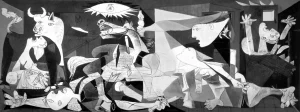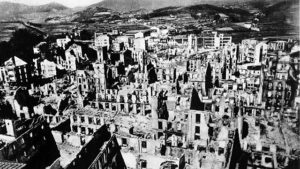The 1937 World’s Fair was the International Exposition held in Paris, highlighting “art and technology in modern life”. Like in previous world fairs, many countries had their own pavilions to display the scientific, artistic, and commercial progress they had made since the last international gathering. The exposition organizers built many of these pavilions in the Trocadéro Gardens, just across the Pont d’Iena from the Eiffel Tower. Among the pavilions in these gardens were those of Austria, Denmark, Egypt, Japan, Romania, Uruguay, and many others. But the two towering structures at the gardens’ entrance after crossing the Pont d’Iena were the Nazi German and Soviet pavilions. Both were incredibly large buildings running parallel to the riverbank, with a German eagle atop one and a pair of workers holding aloft a hammer and sickle atop the other. The two structures almost seemed to have been staring each other down, which retrospectively seems appropriate given the events of the next decade. But at the time, a more evident irony may have struck some visitors. In the shadow of Germany’s swastika-clutching eagle stood the Spanish pavilion. Spain’s building was a more modest affair, built and outfitted by the Spanish Republican government one year into fighting a civil war against nationalist rebels led by General Francisco Franco. The dark irony of having the German and Spanish pavilions so close to each other was because on April 26th, nearly one month before the exposition’s opening, the Nazi air force’s Condor Legion, at Franco’s request, bombed the town of Guernica in Spain’s Basque Country and killed over sixteen hundred civilians in the process. Many historians now say that the town was not a legitimate target and that the bombing constituted a war crime. Nazi German involvement in the bombing campaigns served as practice runs for the blitzkrieg tactics seen in Poland two years later.
News of the bombing shocked the entire world and provoked many artists to create works in response. For example, the Belgian surrealist René Magritte created his painting Le drapeau noir, while the French sculptor René Iché created his bronze statue Guernica. In Iché’s case, he made the sculpture the day after the bombing and considered it so grotesque that he refused to exhibit it during his lifetime. But the one artwork most often associated with the bombing of Guernica is the groundbreaking work by Pablo Picasso, first unveiled at the Paris Exposition’s Spanish Pavilion on July 12th. Despite being one of Spain’s best-known artists, Picasso had been living in Paris for the past thirty-three years. Spain’s Republican government commissioned him to create a mural for the pavilion, namely one that would call greater attention to the ongoing civil war. Five days after the bombing, Picasso abandoned his original ideas for the work and began making sketches for what would eventually become Guernica. He completed the job in thirty-five days.
Guernica is nothing if not chaotic. It consists of human and animal figures, both alive and dead, painted in black, white, and gray. The lifeless bodies, the looks of anguish on some figures’ faces, a hand clutching a broken sword, and the dull color palette convey destruction, havoc, sadness, and everything else that war brings. Guernica received mixed reviews in Paris, with conservative critics bemoaning that the work was too modernist. Spanish republicans criticized the work as failing to take a more overt stance against fascism, while many others complained that the painting did not offer hope for the future among the wreckage and carnage. However, some interpretations of the work fly in the face of these criticisms. The bull is one of the painting’s major figures and likely represents Spain itself, since the bull is considered a sort of national animal. Because of the bull’s reputation as an aggressive animal (no doubt reinforced by Spain’s bullfighting traditions), some interpret its presence in Guernica as representing the destruction wrought by fascist forces on Basque civilians. The figure clutching the broken sword has their other hand outstretched. Picasso placed a stigma in the palm similar to the stigmata Christ received during his crucifixion, indicating martyrdom. Furthermore, two small glimmers of hope are inserted into the work: one is a flower growing right next to the shattered sword, and the other is a dove between the horse and the bull. Though cloaked in shadow, the dove is still alive.
Guernica did not gain widespread popularity until it went on an exhibition tour to drum up support for the Spanish Republican cause. It first traveled across Scandinavia, then to Britain before being sent to the United States. By the time Guernica was first exhibited in New York, General Franco had already claimed victory, and Guernica was being used to promote raising funds to aid Spanish refugees. Picasso gave the painting to New York’s Museum of Modern Art, requesting that the work be brought to Spain only when democracy had been restored. Pablo Picasso would not live to see Guernica displayed in Spain, passing away two-and-a-half years before the start of Spain’s transition to democracy that began with Francisco Franco’s death in 1975. It was only in 1981 that the painting was brought to Spain, where it remains at the Reina Sofía Museum in Madrid.
There are some, particularly Basque nationalists, who say that the painting should be displayed in the Basque Country rather than Madrid. The Guggenheim Museum in Bilbao, just thirteen miles west of Guernica, would be a particularly suitable place to put the painting on display. But regardless of where people go to see it, Guernica remains one of Picasso’s greatest works and one of the greatest anti-war artworks ever created. Upon seeing it in the Spanish Pavilion, Jean Cocteau very presciently commented that Guernica would become a cross that “Franco would always carry on his shoulder.” A large tapestry copy now hangs at the Security Council room’s entrance at the United Nations New York headquarters. Even decades after its creation, the painting’s imagery as an anti-war symbol remained so powerful that when Colin Powell went to the United Nations to justify the invasion of Iraq in 2003, the tapestry was covered up by a blue curtain so that it would not be visible while Powell fielded questions from the press. And just this past February, French artist Jean-Pierre Raynaud created his own work inspired by Picasso’s painting in response to the ongoing war in Ukraine. This shows that Guernica is just as striking and contains a message as important today as it was eighty-six years ago in 1937. As long as there is conflict, there will be people who will invoke Guernica, who will invoke the memories of those killed in Spain, as a way to advocate for those who suffer, and to stand up against those who make war.


